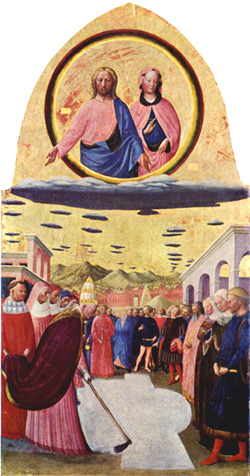Prof. Plinio Corrêa de Oliveira
| Biographical selection: The feast day of Our Lady of the Snow is also the day of the dedication of the Basilica of Santa Maria of the Snows, or Santa Maria Maggiore [Saint Mary Major] in Rome. Since the 7th century it was known also as Maria ad Præsepe because the Basilica has some pieces of wood from the Manger in which Our Lord was born. The ceiling of the Basilica is gilded with the first gold that came from the Americas.
A beautiful legend tells us that Our Lady appeared in dreams simultaneously to Pope Liberius and to the Roman patrician who owned the property where the church would be erected. She commanded the Pope to build a basilica on Esquiline Hill on the site that would be covered with snow the next day. Indeed, during that night of August 4-5, 352, in the very heat of the summer, a miraculous snow fell on the summit of the Hill, indicating the place for the church to be built. This is why this basilica is also called Our Lady of the Snow. The patrician had a similar dream indicating that he should donate the palace and land for the church to be built. Our Lady also told him that she would send the snow as a sign. To commemorate the Miracle of the Snow, every August 5th a cascade of white petals descends from the coffered ceiling onto the altar place during the religious festivities. It was in this church that one Christmas night Our Lady placed the Divine Infant into the arms of St. Cajetan of Thiene. It was here on another Christmas night that St. Ignatius of Loyola celebrated his first Mass. In this church, St. Pius V prayed the Rosary that obtained for the Catholic warriors the victory of Lepanto. There is a chapel in the Basilica that has a picture of Our Lady that, according to tradition, was painted by St. Luke. St. Charles Borromeo used to pray often in front of this Madonna, and in testimony of his gratitude to her, he wrote the Rule of the Canons of Santa Maria Maggiore. |
